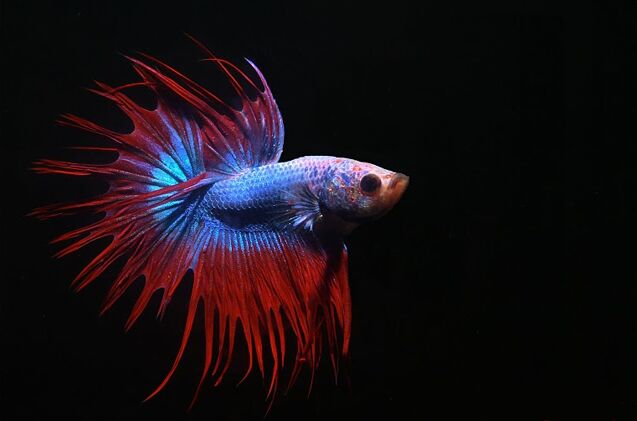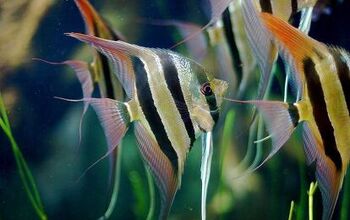Betta Splenden


About Betta Splenden
Betta Splendens are one of the hardiest species of freshwater aquarium fish and are an incredibly popular mainstay among hobbyists. Betta Splenden males are vibrantly colored and have long flowing caudal, dorsal, anal and ventral fins. The females on the other hand have much shorter fins and aren’t as vibrant in color. While the most common type of Betta Splenden found in pet stores is the veil tail Betta, modern Betta Splendens have been selectively bred to create a dazzling array of fin shapes and color variants.
Bettas are a generally peaceful species of fish, but are extremely aggressive towards their own kind. Often referred to as Siamese fighting fish, Betta males cannot be kept together in the same aquarium as they will fight each other, sometimes to the death. When confronted with their own reflections, male Bettas will flare out his gills, spread his fins and attempt to attack this reflection. Males and females should also be kept separately, except when breeding, as the males will harass and attack the females as part of the courtship ritual. However, it is possible to keep one male with several females in a moderately sized aquarium where the females can escape the male’s aggression by swimming out of reach.
Betta Splendens are one of the hardiest species of freshwater aquarium fish and are an incredibly popular mainstay among hobbyists.
Bettas are native to the swamp lands and paddy fields of Thailand, Laos, Vietnam and Cambodia.
Betta Splendens come in a variety of colorations such as blue, turquoise, red, yellow, white, opaque, chocolate and black. They also come in various bi-color and multi-color variants referred to as marbles, butterflies and Cambodians.
Betta Splendens are an incredibly hardy species of aquarium fish, and this sometimes leads to aquarists housing them in very poor aquarium conditions. It is not uncommon to see Betta Splendens housed in tiny jars full of dirty water. However, Betta Splendens thrive when raised in a moderately sized aquarium with lots of plant cover and subdued lighting. Betta Splendens are Labyrinth Fish and are able to breathe by inhaling surface air. For this reason, it is important to ensure that the Betta Splenden aquarium has sufficient open surface areas and also that the water in the aquarium is not disturbed by powerful filters.
Although Bettas can be kept with other types of tropical freshwater fish, they should not be kept with tank mates with large, flowing fins like guppies or angel fish, as the Bettas will often start nipping at them.
Betta Splendens are carnivores and can be fed on a diet of flakes and pellets. Their diet should also be supplemented with protein rich live foods such as bloodworms and mosquito larvae.
Betta Splendens are an incredibly hardy species of aquarium fish, and this sometimes leads to aquarists housing them in very poor aquarium conditions.
Great care should be taken when breeding Bettas because of the particularly violent nature of their mating ritual. If introduced into a small breeding tank, a male will quickly start chasing and harassing a female. For this reason, it is advisable to condition the two fish separately for a week or two prior to breeding on a high protein diet. The female should then be introduced to the male’s breeding tank in a jar or breeding trap. The male will flare his gills and fins and dance around the female, attempting to attack her. If the female is ready to breed at this point, she will often display two to three vertical stripes along her abdominal region. The male will then start constructing a bubble nest by inhaling air from the surface and blowing out tiny bubbles that stick together. Once the bubble nest is complete and the female is released, the male will entice her under the bubble nest and wrap himself around her, squeezing out her eggs and fertilizing them at the same time. This spawning ritual will repeat itself over and over until all the eggs are collected and placed in the bubble nest. Once spawning is complete, the male will chase the female away and she should be then removed from the breeding tank. The male will then take care of the eggs and the newborn fry.
Half-Moon, Crown Tail, Short Tail, Double Tail, Rose Tail, Half-Sun, Elephant Ear, etc.
Photo credit: Daniella Vereeken/Flickr; Anandarajkumar/Wikimedia

Amy Tokic, Editor of PetGuide.com, is a passionate animal lover and proud pet parent of Oscar, a Shih Tzu/Chihuahua cross, and Zed, a Japanese Chin. Her love of animals began in kindergarten, when she brought her stuffed dog Snoopy into class with her every day. Now, she writes about her adventures in pet ownership and tirelessly researches products, news and health related issues she can share with other animal enthusiasts. In her free time, Amy loves perusing used book and record stores, obsessing over the latest pet products available and chasing squirrels with wild abandon (a habit attributed to spending too much time with her pooches).
More by Amy Tokic
























